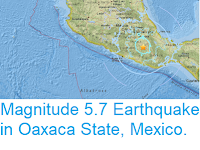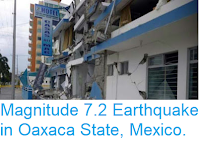Tropical Storm Narda made landfall in Oaxaca State, Mexico, on Saturday 28 September 2019, passing over a coastal regions of Guerrero, Michoácan, Colima, Jalisco, and Nayarit, before passing back out to sea over the Gulf of California. The storm caused two fatalities in Ozxaca, a 26-year-old man in San Pedro Mixtepec, and a 17-year-old boy in San Jeronimo, both of whom were swept away by swollen rivers. A landslide in the town of Santa Catarina Juquila, also in Oaxaca, buried two shops, but nobody was hurt in that incident. In Jalisco State the Cuale River overflowed its banks in Puerto Vallarta, causing damage to 248 houses. Flooding was also reported in the city of Mazatlan in Sinaloa State.
Flooding caused by Tropical Storm Narda in the city of Mazatlan in Sinaloa State. The Mazatlan Post.
Tropical storms are caused by the warming effect of the Sun over
tropical seas. As the air warms it expands, causing a drop in air
pressure, and rises, causing air from outside the area to rush in to
replace it. If this happens over a sufficiently wide area then the
inrushing winds will be affected by centrifugal forces caused by the
Earth's rotation (the Coriolis effect). This means that winds will be
deflected clockwise in the northern hemisphere and anti-clockwise in the
southern hemisphere, eventually creating a large, rotating Tropical
Storm. They have different names in different parts of the world, with
those in the northwest Atlantic and eastern Pacific being referred to as hurricanes.
The path and strength of Tropical Storm Narda. Thick line indicates the
past path of the storm (till 3.00 pm GMT on Tuesday 1 October 2019). Colour indicated the severity of the storm. Tropical Storm Risk.
Despite the obvious danger of winds of this speed, which can physically
blow people, and other large objects, away as well as damaging buildings
and uprooting trees, the real danger from these storms comes from the
flooding they bring. Each drop millibar drop in air-pressure leads to an
approximate 1 cm rise in sea level, with big tropical storms capable of
causing a storm surge of several meters. This is always accompanied by
heavy rainfall, since warm air over the ocean leads to evaporation of
sea water, which is then carried with the storm. These combined often
lead to catastrophic flooding in areas hit by tropical storms.
See also...
Follow Sciency Thoughts on
Facebook.








